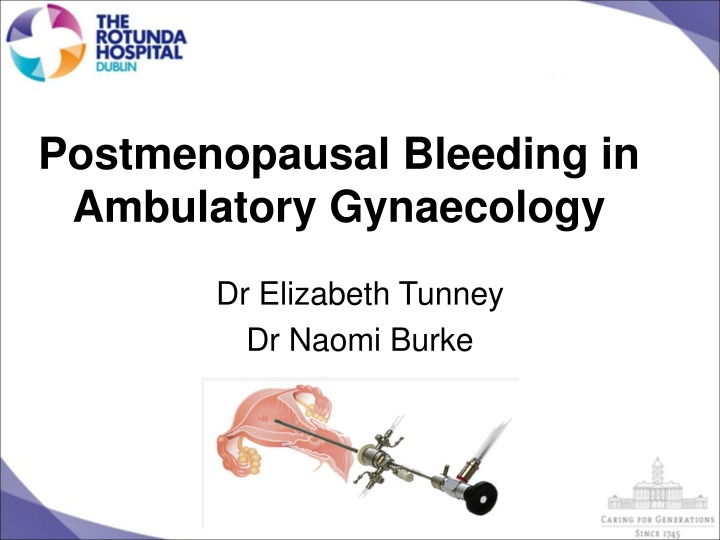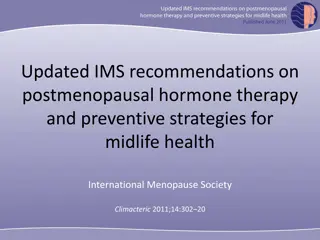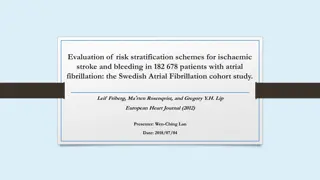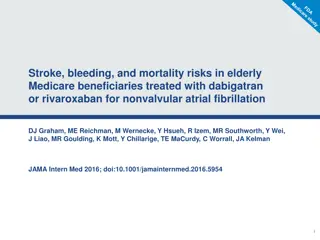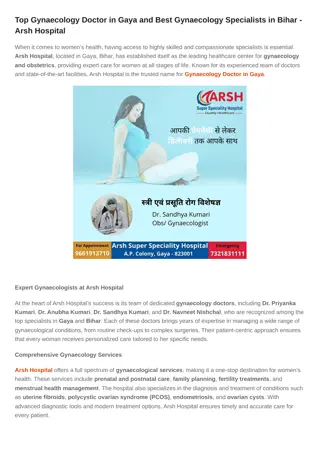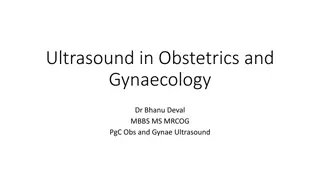Postmenopausal Bleeding in Ambulatory Gynaecology
Critical symptom that may indicate endometrial cancer, but many cases are benign. This study discusses the implementation of ultrasound for PMB patients in an ambulatory gynaecology clinic, emphasizing the need for improved transvaginal sonography practices. The findings highlight the importance of ultrasound in assessing endometrial conditions and the impact of enhancing ultrasound utilization in gynaecological care.
Download Presentation

Please find below an Image/Link to download the presentation.
The content on the website is provided AS IS for your information and personal use only. It may not be sold, licensed, or shared on other websites without obtaining consent from the author.If you encounter any issues during the download, it is possible that the publisher has removed the file from their server.
You are allowed to download the files provided on this website for personal or commercial use, subject to the condition that they are used lawfully. All files are the property of their respective owners.
The content on the website is provided AS IS for your information and personal use only. It may not be sold, licensed, or shared on other websites without obtaining consent from the author.
E N D
Presentation Transcript
Postmenopausal Bleeding in Ambulatory Gynaecology Dr Elizabeth Tunney Dr Naomi Burke
Background & Objective Postmenopausal bleeding ( PMB) is a red flag symptom. Endometrial Cancer most common Gynaecological Malignancy worldwide. However most women with PMB end up having benign disease. The Ambulatory Gynaecology clinic in the Rotunda Hospital has been in operation for over 6 years with the ability to offer ultrasound, hysteroscopy and treatment procedures in the same appointment. This has revolutionized the pathway for women presenting with postmenopausal bleeding. The Price report from the Saolta Group highlighted the need for a clear pathway of care for women with PMB. Change Initiative Ultrasound with image archiving capability in the Ambulatory Gynaecology Department. Implement improved use of Transvaginal
Results & PDSA 1.0 Endometrial assessment (n=26) Endometrial Thickness <4mm >4mm Ultrasound Performed (n=26) 10 16 Prior to appointment 18 (69%) 2 Cases of Endometrial CA On day of appointment 6 (23%) After appointment 2 (8%) Total patients: 60 Audit of PMB referrals in the Ambulatory Gynaecology Dept commenced. Adherence with national guideline for PMB management used as audit standard. Audit findings presented. TV Ultrasound with archive imaging capability installed. Aim for next audit cycle: Review % patients who will have US + whether increased compliance with NWHIP PMB management guidance. Data compiled & analyzed. Findings extrapolated & interpreted. Analysis completed Findings summarized & presented. Transvaginal Ultrasound utility identified as area for improvement.
Conclusions Transvaginal sonography plays an important role in initial assessment of the endometrium in the PMB context. Our audit confirmed 57% of PMB patients had no Ultrasound completed & Ultrasound was not being implemented effectively. Direct result: Installation of a Transvaginal Ultrasound machine & Viewpoint Image Archiving Capability in the Department with immediate effect. Our project delivered on the need for enhanced use of ultrasonography in the Ambulatory Gynaecology Setting. This clinical improvement will benefit Postmenopausal patients but also pre-menopausal patients presenting with a variety of common gynaecological issues.
